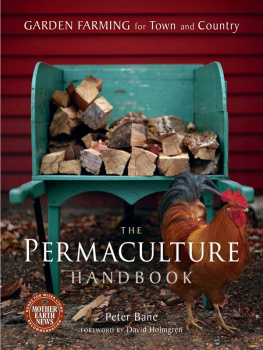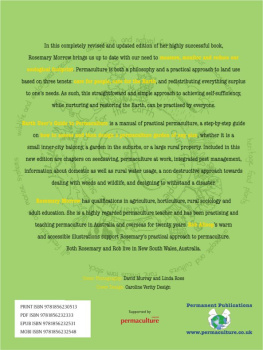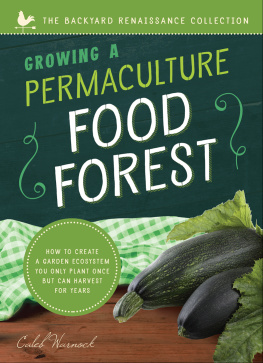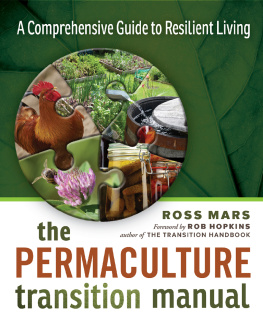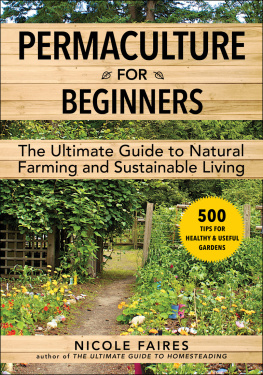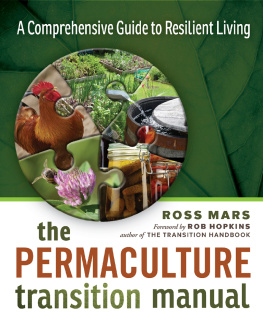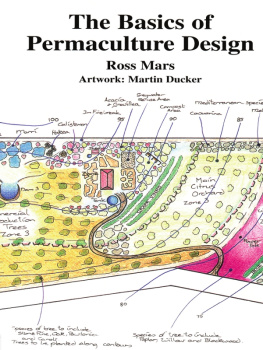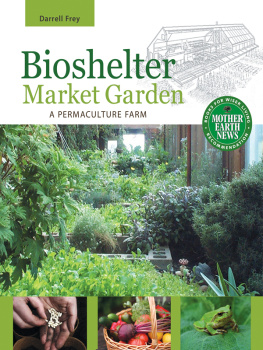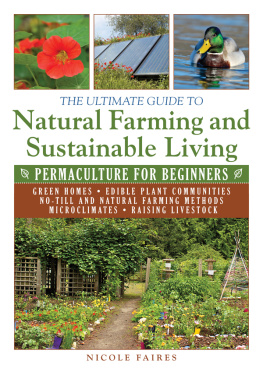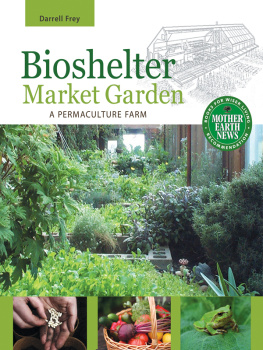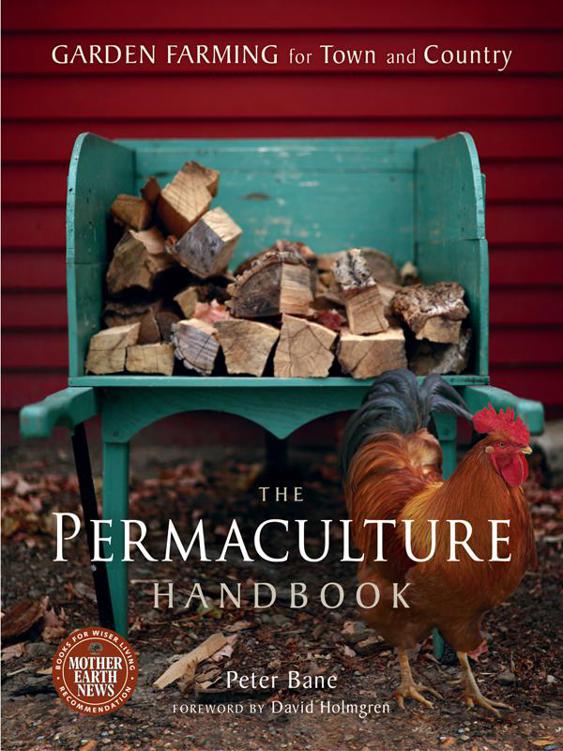
Praise for The Permaculture Handbook
When Apollo 13 found itself hurtling through space on its way to the far side of the moon with a ruptured oxygen tank, a critical path was assembled that returned all souls safely back to Earth. In The Permaculture Handbook , Peter Bane has mapped the critical path to a safe landing for civilization in the 21st century. That path runs through the backyards of suburbia and across the rooftops and balconies of urban apartment houses. Like the Apollo mission, Bane has jury-rigged our carbon dioxide removal system by re-tasking other components small scale horticulture, aquatic plants and foraged trash, for instance to buy us breathing room. This is a must read.
Albert Bates, author of The Post Petroleum Survival Guide and Cookbook , and The Biochar Solution .
The Permaculture Handbook offers practical examples from the authors many years of experience, coupled with information from permaculture practitioners from around the country. This makes the guidebook particularly useful to American readers. The chapters covering the integration of multifunctional species and breeds of domestic animals and wildlife are especially note-worthy. These chapters address the sometimes under-recognized value of animal products and services in the Permaculture literature. This book is a joy to read while thinking about applications to ones own endeavors.
Donald Bixby, DVM, Retired Executive Director of American Livestock Breeds Conservancy
Peter Banes characteristic generosity and mastery are on display in this long anticipated encyclopedia of permaculture knowledge and lore. The Permaculture Handbook offers a thorough treatment of the design principles and patterns that of necessity precede the positive, practical, and profitable solutions that are the hallmark of permaculture design. Bill Mollison famously taught that we can create the Garden of Eatin. Peter Bane shows us how.
Claude William Genest, Former Deputy Leader of the Green Party of Canada. Producer, Host of the Emmy nominated PBS series Regeneration: The Art of Sustainable Living
As oil becomes more scarce and expensive, society must adapt by re-localizing food systems. The Permaculture Handbook offers us a set of essential conceptual and practical tools for doing this in a way thats intelligent, beautiful, and sustainable. Want to create a better world? Your backyard and this book are the places to start.
Richard Heinberg, Senior Fellow, Post Carbon Institute, Author, The End of Growth
Here is an exquisite design manual for re-inhabiting our towns and cities, transforming them into flourishing and nourishing landscapes that provide food, fiber, energy and community. As you read this book, looking out from time to time at the paved, manicured tracts weve called home, you can almost see the world around you transforming a fruit tree here, a greenhouse there, a hill of corn, beans and squash in the corner, a photovoltaic array that charges your electric bicycle nearby. We are not in an era of despair, of coming apart. We are in an era of creativity where strong seeds grow in the very cracks in the concrete of our old ways of living. I applaud Peter for the wisdom, intelligence and hard work he has invested in his detailed, beautiful map of the land of permaculture.
Vicki Robin, author Your Money or Your Life and Blessing the Hands that Feed Us (Viking/Penguin 2013).
Peter Bane offers a powerful antidote to what we might call our ephemeraculture the consumerist, oil-dependent, wasteful, and ruinous way of life produced by the marriage of industrialism and capitalism. In a voice at once practical and visionary, he tells how we can achieve security, practice self-reliance, and revive local economies by shifting to a regenerative form of agriculture, beginning in our own backyards. If youre hungry for hope, good food, neighborliness, conviviality, and survival skills, here is the book for you.
Scott Russell Sanders, author of A Conservationist Manifesto .
Morally mature cultures live well with the Earth and with each other. Peter Banes beautifully written book lays out a path to that maturity and wisdom. Future generations will thank him and you if you read and use the wisdom he has gathered.
Carolyn Raffensperger, Environmental lawyer, advocate for future generations, Executive Director of the Science and Environmental Health Network
The wealth of practical knowledge in The Permaculture Handbook is a welcome addition to North Americas canon of books on permaculture design, and will serve other regions as well. Peter Banes broad and well-tested experience in ecological living, expressed here in clear and engaging prose, will guide homeowners, gardeners, and small farmers toward designing and living in lushly productive and harmonious landscapes.
Toby Hemenway, author of Gaias Garden: A Guide to Home-Scale Permaculture
A book to carry us through to Eden, this keen, comprehensive design guide with its wisdom and instruction will be indispensable to any household aiming at flourishing, soil-based self-reliance. The practice is permaculture and Peter Bane is a true master.
Stephanie Mills, author of On Gandhis Path and Epicurean Simplicity
With a lifetime of Permaculture immersion under his belt, Peter Banes contribution to domestic self-reliant security in this comprehensive handbook is nothing short of remarkable. This will empower thousands of seekers to move off the bleachers and into the game. He balances beautifully the right amount of intensive ecological information with delightful case studies and practical outworkings. A gem of a manual. Thank you, Peter.
Joel Salatin, Author, Farmer
There are a lot of people out there who want to know how to begin making a better world, but dont know where to begin. I cant think of a better starting point for someone who wants to restore and transform their place than Peter Banes Permaculture Handbook . Bane has taken the single most urgent question of our times How shall we live? and given a real and viable answer.
Sharon Astyk, writer, farmer, teacher and author of Making Home
The Permaculture Handbook is worth reading and rereading not only for its depth of insight but also for its storytelling charm. Peter Banes reflections on community-based efforts to realize permacultures potential across entire landscapes helps us realize that this set of design principles are not vague abstractions, but something that we can smell, taste and see before our very eyes.
Gary Paul Nabhan, ethnobotanist, writer, permaculture orchardkeeper, seed saver
THE
PERMACULTURE
HANDBOOK
by
Peter Bane

Copyright 2012 by Peter Bane.
All rights reserved.
Cover design by Diane McIntosh.
Main image: iStock (Jim Schemel); Rooster: iStock (pastoor)
First printing May 2012
Ebook ISBN 978-1-55092-485-5
Inquiries regarding requests to reprint all or part of The Permaculture Handbook
should be addressed to New Society Publishers at the address below.
To order directly from the publishers, please call toll-free
(North America) 1-800-567-6772, or order online at
www.newsociety.com
Any other inquiries can be directed by mail to:
New Society Publishers
P.O. Box 189, Gabriola Island, BC V0R 1X0, Canada
(250) 247-9737
New Society Publishers mission is to publish books that contribute in fundamental ways to building an ecologically sustainable and just society, and to do so with the least possible impact on the environment, in a manner that models this vision. We are committed to doing this not just through education, but through action. The interior pages of our bound books are printed on Forest Stewardship Council-registered acid-free paper that is 100% post-consumer recycled (100% old growth forest-free), processed chlorine free, and printed with vegetable-based, low-VOC inks, with covers produced using FSC-registered stock. New Society also works to reduce its carbon footprint, and purchases carbon offsets based on an annual audit to ensure a carbon neutral footprint. For further information, or to browse our full list of books and purchase securely, visit our website at: www.newsociety.com
Next page
